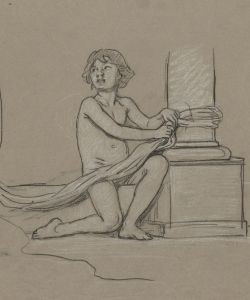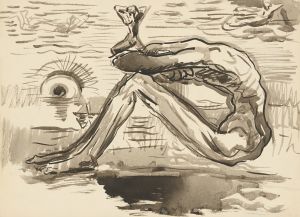
Study of a head of a woman
A hand-painted replica of Jean-Jacques Henner’s masterpiece Study of a head of a woman, meticulously crafted by professional artists to capture the true essence of the original. Each piece is created with museum-quality canvas and rare mineral pigments, carefully painted by experienced artists with delicate brushstrokes and rich, layered colors to perfectly recreate the texture of the original artwork. Unlike machine-printed reproductions, this hand-painted version brings the painting to life, infused with the artist’s emotions and skill in every stroke. Whether for personal collection or home decoration, it instantly elevates the artistic atmosphere of any space.
Jean-Jacques Henner (1829–1905) was a renowned French painter known for his portraits, nudes, and religious subjects. One of his notable works is "Study of a Head of a Woman," which exemplifies his skill in capturing the delicate features and expressions of his subjects.
Henner was born in Bernwiller, Alsace, and studied at the École des Beaux-Arts in Paris under Michel Martin Drolling and François-Édouard Picot. He won the prestigious Prix de Rome in 1858, which allowed him to study in Italy. This experience greatly influenced his style, particularly his use of chiaroscuro and his focus on the human form.
"Study of a Head of a Woman" is a fine example of Henner's portrait studies. The painting showcases a woman's head, rendered with meticulous attention to detail and a soft, almost ethereal quality. Henner's use of light and shadow creates a sense of depth and realism, while his delicate brushwork highlights the subtle textures of the woman's skin and hair.
The subject of the painting is depicted with a serene expression, her gaze directed slightly away from the viewer. This pose, combined with the soft lighting, gives the portrait an introspective and contemplative mood. Henner often chose such poses and expressions to convey a sense of inner life and emotion in his subjects.
Henner's technique in this study is characteristic of his broader body of work. He often employed a limited color palette, focusing on shades of brown, ochre, and white to create a harmonious and cohesive composition. This restrained use of color allows the viewer to focus on the form and expression of the subject without distraction.
The background of the painting is typically simple and unobtrusive, ensuring that the viewer's attention remains on the woman's face. This approach is consistent with Henner's belief in the importance of the human figure as the central element of his compositions.
Throughout his career, Henner received numerous accolades and his works were exhibited widely. He was a member of the Académie des Beaux-Arts and was awarded the Grand Cross of the Legion of Honour in 1903. His legacy includes not only his paintings but also his influence on future generations of artists.
"Study of a Head of a Woman" remains a testament to Henner's skill as a portraitist and his ability to capture the subtle nuances of human expression. The painting is a valuable piece of art history, reflecting the techniques and aesthetics of 19th-century French painting.
Henner's works, including this study, can be found in various museums and collections around the world. The Musée Jean-Jacques Henner in Paris, dedicated to his life and work, houses many of his paintings and offers insight into his artistic process and achievements.
In summary, "Study of a Head of a Woman" by Jean-Jacques Henner is a masterful portrait study that exemplifies the artist's skill in rendering the human form with sensitivity and precision. Henner's use of light, shadow, and a limited color palette creates a compelling and introspective image that continues to be admired by art enthusiasts and scholars alike.


















